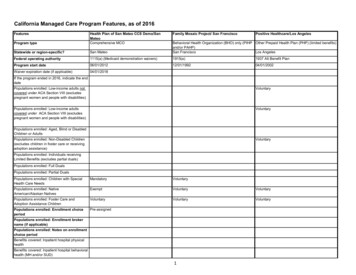
Transcription
This page intentionally left blank
A Handbook for the Study of Mental HealthSecond EditionSocial Contexts, Theories, and SystemsThe second edition of A Handbook for the Study of Mental Health: Social Contexts, Theories, and Systems provides a comprehensive review of the sociologyof mental health, with chapters written by leading scholars and researchers. Thevolume presents an overview of historical, social, and institutional frameworks forunderstanding mental health and illness. Part I examines social factors that shapepsychiatric diagnosis and the measurement of mental health and illness, the theories that explain the definition and treatment of mental disorders, and culturalvariability in mental health. Part II investigates effects of social context on mentalhealth and illness. Individual chapters consider the role of social statuses, includingclass, gender, race, and age. Several chapters focus on the critical role played bystress, marriage, work, and social support, with a concluding chapter focusing onterrorism. Part III focuses on the organization, delivery, and evaluation of mentalhealth services, including a discussion of the criminalization of mental illness, themental health challenges posed by HIV, and the importance of stigma in meetingthe mental health needs of individuals. A Handbook for the Study of Mental Healthis a key resource that will be useful to both undergraduates and graduate studentsstudying mental health and illness from any number of disciplines.Teresa L. Scheid is Professor of Sociology and serves on the faculty for doctoralprograms in public policy, organization science, and health services research atthe University of North Carolina at Charlotte. She has published widely on theorganization and delivery of mental health care services with a focus on thework of mental health care providers. This work is reflected in her book, Tie aKnot and Hang On: Providing Mental Health Care in a Turbulent Environment(2004). Professor Scheid’s current work has expanded to examine the mentalhealth consequences of HIV.Tony N. Brown is Associate Professor of Sociology and holds secondary appointments in Psychology and Human Development, and Human and OrganizationalDevelopment at Vanderbilt University. He also serves on the faculty of the Programin African American and Diaspora Studies; the Developmental PsychopathologyResearch Training Program; the Center for Medicine, Health, and Society; and theCenter for Evaluation and Program Improvement. His research interests include themental health impact of race-related stressors, racial identity, ethnic/race socialization, the conceptualization of mental health, and psychiatric epidemiology. Inrecent work, he examines the psychological costs of racism for Blacks as well asthe mental health benefits that some Whites receive because of racism.
A Handbook for the Study ofMental HealthSecond EditionSocial Contexts, Theories, and SystemsEdited byTERESA L. SCHEIDTONY N. BROWNUniversity of North Carolinaat CharlotteVanderbilt University
CAMBRIDGE UNIVERSITY PRESSCambridge, New York, Melbourne, Madrid, Cape Town, Singapore,São Paulo, Delhi, Dubai, TokyoCambridge University PressThe Edinburgh Building, Cambridge CB2 8RU, UKPublished in the United States of America by Cambridge University Press, New Yorkwww.cambridge.orgInformation on this title: www.cambridge.org/9780521491945 Cambridge University Press 2010This publication is in copyright. Subject to statutory exception and to theprovision of relevant collective licensing agreements, no reproduction of any partmay take place without the written permission of Cambridge University Press.First published in print format 2009ISBN-13978-0-511-65850-1eBook 3978-0-521-72891-1PaperbackCambridge University Press has no responsibility for the persistence or accuracyof urls for external or third-party internet websites referred to in this publication,and does not guarantee that any content on such websites is, or will remain,accurate or appropriate.
We dedicate this volume to James R. Greenley,who devoted his personal and professionallife to the improvement of mental health services.
ContentsContributorsForeword by David MechanicPrefacePart IApproaches to Mental Health and Illness: ConflictingDefinitions and EmphasesTeresa L. Scheid and Tony N. Brown1 An Overview of Sociological Perspectives on the Definitions,Causes, and Responses to Mental Health and IllnessAllan V. Horwitz2 The Measurement of Mental DisorderJerome C. Wakefield and Mark F. Schmitz3 The Prevalence of Mental IllnessRonald C. Kessler4 Biological Theories of Psychiatric Disorders:A Sociological ApproachSharon Schwartz and Cheryl Corcoran5 Psychological Approaches to Mental IllnessChristopher Peterson6 Sociological Approaches to Mental IllnessPeggy A. Thoits7 Viewing Mental Health from the Complete State ParadigmCorey L. M. Keyes and Barret Michalec8 Mental Health Systems in a Cross-Cultural ContextHarriet P. Lefleypage xixvxix1620466489106125135vii
viiiContentsPart II The Social Context of Mental Health and IllnessTony N. Brown and Teresa L. Scheid1639 Stressors, Stress, and DistressBlair Wheaton and Shirin Montazer10 Social Support and Mental HealthR. Jay Turner and Robyn Lewis Brown11 Work and Unemployment as StressorsMary Clare Lennon and Laura Limonic12 Socioeconomic Stratification and Mental DisorderWilliam W. Eaton, Carles Muntaner, and Jaime C. Sapag13 Gender and Mental Health: Do Men and Women Have DifferentAmounts or Types of Problems?Sarah Rosenfield and Dena Smith17114 Race and Mental Health: Patterns and ChallengesDavid R. Williams, Manuela Costa, and Jacinta P. Leavell15 African American Women and Mental Well-Being: TheTriangulation of Race, Gender, and Socioeconomic StatusVerna M. Keith and Diane R. Brown20021322625626829116 Marital Status and Mental HealthKristi Williams, Adrianne Frech, and Daniel L. Carlson30617 Stress and Distress in Childhood and AdolescenceElizabeth G. Menaghan32118 Psychopathology and Risky Sexual Behaviors amongBlack AdolescentsCleopatra Howard Caldwell and Ebony Sandusky19 Well-Being across the Life CourseJohn Mirowsky and Catherine E. Ross33436120 Mental Health and TerrorismRobert J. Johnson and Stevan E. Hobfoll384Part III Mental Health Systems and PolicyTeresa L. Scheid and Tony N. Brown40721 Understanding the Context and Dynamic Social Processes ofMental Health TreatmentBernice A. Pescosolido and Carol A. Boyer22 Cultural Diversity and Mental Health TreatmentEmily Walton, Kateri Berasi, David T. Takeuchi, andEdwina S. Uehara420439
Contents23 The Mental Health Consumers/Survivors Movement inthe United StatesAthena McLean24 Mental Illness and the Criminal Justice SystemVirginia Aldigé Hiday and Padraic J. Burns25 Mental Health Care in Organizations and SystemsMichael Polgar26 Integrating Service Delivery Systems for Persons with a SevereMental IllnessGary S. Cuddeback and Joseph P. Morrissey27 Consequences of Managed Care for Mental Health ProvidersTeresa L. Scheid28 Mental Health and the Changing Context of HIVJames Walkup and Stephen Crystal29 Labeling and StigmaBruce G. Link and Jo C. PhelanReferencesIndexix461478499510529548571589707
ContributorsKateri Berasi, EdMGraduate StudentTeachers CollegeColumbia UniversityCarol A. Boyer, PhDAssociate Director, Institute for Health,Health Care Policy, and Aging ResearchRutgers, The State University ofNew JerseyDiane R. Brown, PhDProfessorHealth Education and BehavioralScienceInstitute for the Elimination of HealthDisparitiesUMDNJ-School of Public HealthRobyn Lewis Brown, MSDoctoral Candidate, Department ofSociologyFlorida State UniversityTony N. Brown, PhDAssociate Professor of SociologyFaculty Head of Hank Ingram House,The CommonsResearch Fellow, Vanderbilt Center forNashville StudiesVanderbilt UniversityPadraic J. Burns, MADoctoral Candidate, Department ofSociologyNorth Carolina State UniversityCleopatra Howard Caldwell, PhDAssociate ProfessorDepartment of Health Behavior andHealth EducationSchool of Public HealthUniversity of Michigan, Ann ArborDaniel L. Carlson, MADoctoral Candidate, Department ofSociologyThe Ohio State UniversityCheryl Corcoran, MDFlorence Irving Assistant Professor ofClinical PsychiatryColumbia University and DirectorCenter of Prevention andEvaluationNew York Psychiatric InstituteManuela Costa, MPHDoctoral Candidate, Department ofSociety, Human Development, andHealthHarvard School of Public HealthStephen Crystal, PhDDirector, Center for Pharmacotherapy,Chronic Disease Management andOutcomes and Center for Educationand Research on Mental HealthTherapeuticsResearch Professor and Chair, Divisionon Agingxi
xiiContributorsAssociate Institute Director forHealth Services Research, Instituteon Health, Health Care Policy, andAging ResearchRutgers, The State University ofNew JerseyGary S. Cuddeback, PhDAssistant Professor of Social WorkResearch Fellow, Cecil G. Sheps Centerfor Health Services ResearchUniversity of North Carolina atChapel HillWilliam W. Eaton, PhDSylvia and Harold Halpert Professorand Chair, Department of MentalHealthJohns Hopkins Bloomberg School ofPublic HealthAdrianne Frech, PhDPostdoctoral FellowRice UniversityVirginia Aldigé Hiday, PhDProfessor, Department of Sociology andAnthropologyNorth Carolina State UniversityStevan E. Hobfoll, PhDThe Judd and Marjorie WeinbergPresidential Professor andChairRush University Medical CenterAllan V. Horwitz, PhDProfessor of Sociology and Dean of Socialand Behavioral SciencesSchool of Arts and SciencesRutgers, The State University ofNew JerseyRobert J. Johnson, PhDProfessor and ChairpersonDepartment of SociologyUniversity of MiamiVerna M. Keith, PhDProfessorDepartment of SociologyCenter for Demography and PopulationHealthFlorida State UniversityRonald C. Kessler, PhDProfessor, Department of Health CarePolicyHarvard Medical SchoolCorey L. M. Keyes, PhDAssociate Professor, Department ofSociologyEmory UniversityJacinta P. Leavell, PhDAssociate Professor, School ofDentistryMeharry Medical CollegeHarriet P. Lefley, PhDProfessor, Department of Psychiatry andBehavioral SciencesUniversity of Miami Miller School ofMedicineMary Clare Lennon, PhDProfessorPhD Program in SociologyThe Graduate CenterCity University of New YorkLaura Limonic, MAThe Graduate CenterCity University of New YorkBruce G. Link, PhDProfessor, Epidemiology andSociomedical SciencesSchool of Public HealthColumbia UniversityAthena McLean, PhDProfessor of Anthropology, Departmentof Sociology, Anthropology andSocial WorkCentral Michigan UniversityDavid Mechanic, PhDDirector and Rene Dubos UniversityProfessorInstitute for Health, Health Care Policy,and Aging ResearchRutgers, The State University ofNew Jersey
ContributorsxiiiElizabeth G. Menaghan, PhDProfessor, Department of SociologyThe Ohio State UniversitySchool of Public HealthColumbia UniversityBarret Michalec, PhDAssistant Professor, Department ofSociologyUniversity of DelawareMichael Polgar, PhDDepartment of SociologyPenn State UniversityJohn Mirowsky, PhDProfessor, Department of Sociology andPopulation Research CenterUniversity of TexasShirin MontazerDoctoral CandidateDepartment of SociologyUniversity of TorontoJoseph P. Morrissey, PhDProfessor of Health Policy, Management,and PsychiatryDeputy Director, Cecil G. Sheps Centerfor Health ServicesUniversity of North Carolina at ChapelHillCarles Muntaner, PhDPsychiatry and Addictions NursingResearch ChairSocial Equity and Health Section,Social Policy and PreventionDepartmentCenter for Addictions and Mental HealthandProfessor of Nursing, Public Health andPsychiatryUniversity of TorontoBernice A. Pescosolido, PhDProfessor, Department of Sociology andConsortium for Mental Health ServicesResearch andDirector, Indiana Consortium for MentalHealth Services ResearchIndiana University-BloomingtonChristopher Peterson, PhDProfessor, Department of PsychiatryUniversity of MichiganJo C. Phelan, PhDAssociate Professor of SociomedicalSciencesSarah Rosenfield, PhDDepartment of SociologyInstitute for Health, Health Care Policy,and Aging ResearchRutgers, The State University ofNew JerseyCatherine E. RossProfessor, Department of Sociology andPopulation Research CenterUniversity of Texas, AustinEbony Sandusky, MPHDoctoral Student, Department of HealthBehavior and Health EducationSchool of Public HealthUniversity of Michigan, Ann ArborJaime C. Sapag, MD, MPHSpecial Advisor, Office of InternationalHealthCentre for Addiction and MentalHealthOntario, CanadaTeresa L. Scheid, PhDProfessor, Department of SociologyUniversity of North Carolina atCharlotteMark F. Schmitz, PhDAssociate Professor, School of SocialAdministrationTemple UniversitySharon Schwartz, PhDProfessor of Clinical EpidemiologyMailman School of Public HealthColumbia UniversityDena Smith, MADoctoral Student, Department ofSociology
xivContributorsRutgers, The State University ofNew JerseyDavid T. Takeuchi, PhDProfessor, Department of Sociology andSocial WorkUniversity of WashingtonPeggy A. Thoits, PhDProfessorDepartment of SociologyIndiana UniversityR. Jay Turner, PhDMarie E. Coward Professor of Sociologyand EpidemiologyProfessor of PsychologyFlorida State UniversityEdwina S. Uehara, PhDProfessorDepartment of SociologyUniversity of WashingtonJerome C. Wakefield, PhD, DSWUniversity Professor, Silver Schoolof Social Work and Departmentof Psychiatry, School ofMedicineNew York UniversityJames Walkup, PhDGraduate School of Applied andProfessional Psychology andInstitute for Health, Health Care Policy,and Aging ResearchRutgers, The State University ofNew JerseyEmily WaltonDepartment of SociologyUniversity of WashingtonBlair Wheaton, PhDProfessor and Chair, Department ofSociologyUniversity of TorontoDavid R. Williams, PhDFlorence and Laura Norman Professor ofPublic HealthProfessor of African and AfricanAmerican Studies and ofSociologyStaff Director, RWJF Commission toBuild a Healthier AmericaHarvard School of Public HealthKristi Williams, PhDAssociate Professor, Department ofSociologyThe Ohio State University
ForewordThe National Institute of Mental Health (NIMH), established at the end of WorldWar II, had an important influence on the growth of medical sociology and especially on social research in mental health. Its first director, Robert Felix, soughtto include the social sciences as basic sciences for the study of mental healthissues and problems. He strongly supported PhD training and extramural researchand contributed to the growth of sociology, anthropology, and psychology as disciplinary areas. The fact that initially public support for sociology largely camethrough NIMH rather than other disease-oriented institutes explains the dominance of mental health concerns within the development of medical sociology.With increasing numbers of sociologists trained in NIMH programs, medicalsociology became one of the largest and most active sections of the AmericanSociological Association (ASA). Felix was committed to bringing a public healthperspective to the study and treatment of persons with mental illness, a viewpointthat began to erode during the Reagan administration when politics forced NIMHinto a more insular disease perspective. The public health view has now againgained some traction on the nation’s health agenda, with a renewed interest insocial determinants of health and socioeconomic and ethnic/racial disparities.In earlier decades, training programs encompassed broad areas of social psychology, social organization, and social methodology; this breadth encouraged thewide range of substantive interests and theoretical and methodological approachesexhibited in this Handbook. NIMH predoctoral and postdoctoral awards supportedmy training in the 1950s, and probably many, if not most, of the contributors tothis Handbook had similar support during their disciplinary training. I have beeninvolved for almost 50 years in running such training programs at the Universityof Wisconsin and Rutgers University; in the earlier decades these programs hada strong focus on promoting and expanding knowledge and methods in the basicareas of the discipline. Many of those who participated in these and related programs have contributed importantly not only to mental health but also to theirdisciplines. Programs funded today are much more focused on problem areas andxv
xviForewordinterdisciplinary efforts, but it remains essential for researchers to be stronglyinvolved with the conceptual, theoretical, and methodological advances in theirdisciplines if they are to be effective partners in interdisciplinary collaborations.This Handbook nicely informs readers on conceptual, substantive, and policyaspects of mental health. A core issue that engages every aspect of mental healthresearch and practice is the conceptualization of mental health itself: Is it seenmost usefully in terms of discrete disorders or in terms of continua of affect andfunction? There is some resurgence of interest in conceptualizing positive mentalhealth as well, although determining the role of culture and values in framingwhat is seen as positive remains a difficult challenge. As the mental health fieldprepares to introduce version V of the Diagnostic and Statistical Manual of MentalDisorders (DSM-V), many groups have intense interest in its structure and content.Whatever one might think of DSM, it will continue to have an important role inreimbursement arrangements, disability determinations, legal contests, and thepromotion and marketing of drugs and other therapies. We clearly need a reliableclassificatory basis for research, for treatment assessment, and for communication,but absence of a theoretical basis for DSM entities and disagreements about itsinclusiveness leave much room for controversy and debate. It remains uncertainwhether social understanding is enhanced more by a focus on discrete disordersas defined by DSM or whether we might benefit more by attention to dimensionalconceptualizations and inquiries. Both are important and respond to differentpurposes and needs, but it is clear that the balance among approaches requiresreexamination.The excesses of pharmaceutical marketing, its role in expanding concepts ofdisorder, and its influence on drug research and professional education have donea great deal to undermine trust in psychiatric research results and psychiatricexpertise. Selective publication of drug trials in research funded and controlledby pharmaceutical companies has cast suspicion on the validity of psychiatricknowledge and effectiveness claims. There is now a considerable backlash againstmany of the marketing and funding practices of these large companies and muchgreater skepticism among educators, editors of major journals, and the media.Social research has been an important antidote to this negative pattern and hascontributed importantly to revealing and understanding these patterns of professional and commercial self-interest and how they have helped shape trends in themental health sector.The substance of mental health inquiry is very much focused on the study ofdevelopmental processes across the life course and the influence on those processes of social stratification and important social institutions such as the family,the labor market, and work. Social and epidemiological surveys have become thecore tools for many of these studies that seek to understand human developmentand social behavior across age cohorts and historical periods while being sensitiveto the crucial way in which biological predispositions interact with social context
Forewordxviiand the environment. Surveys have become larger, technically more sophisticatedand longitudinal in scope, and the ability to link varying sources of data makes itincreasingly possible to examine causal ideas with more credibility. Randomizedstudies remain the “gold standard” because social selection is so powerful and pervasive and difficult to discount, but increasingly, natural experiments, longitudinaldatabases, and the use of instrumental variables and sophisticated multivariateapproaches make causal interpretations more convincing in the typical instance inwhich randomization is not feasible or ethical.We value knowledge and understanding for their own sake, but most of usstudy mental health issues and are supported by research agencies because of theexpectation that enhanced knowledge will improve people’s lives. The Americanhealth system, even more its mental health system, is dysfunctional and in shambles. Dealing effectively with serious mental illness involves many sectors fromgeneral medicine to the criminal justice system, but there is little effective coordination or integration. Some of what we already know has been implemented in aconstructive way, but far too much of what we have learned remains to be applied.Whether we are concerned with broad social determinants such as extreme poverty,child abuse and neglect, inferior schooling, and stigmatization on the one handor the lack of access to mental health services and a lack of appropriate balancein treatment among medication, supportive care, and rehabilitative services onthe other, there remains a great gap between what we know and what gets done.Some positive changes have occurred, such as the growing acceptance of mentalhealth as an important aspect of health, the move to greater health insurance parity,more coverage for serious mental illness in public programs such as Medicaid,and more accessibility to treatment and trained mental health professionals. But asthis Handbook makes clear, the social determinants of mental health problems andtheir management will continue to remain challenging for scientists, professionals,and policy makers.David MechanicRutgers University
PrefaceWe are pleased to edit the second edition of A Handbook for the Study of MentalHealth. We worked hard to bring it out on roughly the 10-year anniversary ofthe first edition, which is still widely used in many classrooms and by manyresearchers. Allan V. Horwitz was the senior editor on the first edition, and he suggested Tony N. Brown as someone who would be most instrumental in rethinkingthe second edition. As a consequence, we have included a number of new chapters that target emerging areas of research. We are especially pleased to have achapter on subjective well-being to augment the theories presented in Part I. InPart II we have added several chapters that focus on mental health among minoritygroups: one chapter on Black adolescents and a second on the intersection of race,socioeconomic status, and gender. Part II also includes a new chapter on marriageand another on mental health and terrorism. Part III includes two new chapters onorganizations and mental health care providers.We want to thank everyone who worked so hard to update and extend theirchapters, as well as those who wrote new material for the volume. We owemuch to the students who handled many of the more tedious details in puttingthe Handbook together: Radhi Gosai at University of North Carolina-Charlotte,who merged the references, and Whitney Laster and Nakia Collins at VanderbiltUniversity, who took on the indexing. Ed Parsons at Cambridge University Presswas patient and always available for any question and has been a pleasure to workwith. As with the first edition, proceeds from this volume benefit the AmericanSociological Association Section on Mental Health.xix
Part IApproaches to Mental Healthand Illness: Conflicting Definitionsand EmphasesTeresa L. Scheid and Tony N. BrownMental health and mental disorder represent two different areas of theory, research,and policy implications, reflecting our tendency to dichotomize healthy and sick,normal and abnormal, and sane and insane. David Mechanic (2006) has arguedthat the term “mental health” has no clear or consistent meaning, and in thesociological literature, this argument is generally true. Mental health is not merelythe absence of disease or disorder; it involves self-esteem, mastery, and the abilityto maintain meaningful relationships with others. The concept of mental healthis better developed in the psychology literature, and Carol Ryff has provided anexceptional account of “happiness” that draws on the theories of Maslow, Rogers,Jung, and Allport to develop a multidimensional construct of psychological wellbeing (Ryff, 1989). Although most of us fall short of achieving optimal well-beingor happiness, those who experience mental health problems or psychologicaldistress have been the focus of most sociological research.However, definitions of mental health problems, or illnesses, or disorders arealso not so straightforward. According to Horwitz (2002), “mental diseases” reflectunderlying internal dysfunctions that have universal features (e.g., schizophreniaand to a lesser degree bipolar disorder). A valid “mental disorder” reflects someinternal psychological system that is unable to function as it should, and this dysfunction is socially inappropriate. For most disorders, symptoms are not specificindicators of discrete underlying diseases (such as schizophrenia); instead manyconditions (such as depression, anxiety, and eating disorders) arise from stressfulsocial conditions. Thus symptoms associated with mental disorders are shaped bycultural processes, and it is important to distinguish mental disorders from normalreactions to social stressors. Horwitz (2002) used the terminology of “mental illness” to refer to those conditions that a particular group has defined as a mentalillness and that often includes behaviors that are deemed deviant; for example,homosexuality in previous psychiatric classifications. In Chapter 1, Horwitz arguesthat sociological approaches regard mental health and mental health problems1
2Teresa L. Scheid and Tony N. Brownas aspects of social circumstances. He provides a very thorough overview of howvarious social conditions affect degrees of mental health and mental health problems and, consequently, how social context shapes the definition as well as theresponse to mental health problems.It is also important to understand that there have been two different approachesto differentiating between mental health and illness. One approach views mentalhealth and illness in terms of a continuum, with health and illness at opposite endsof the poles and most of us falling somewhere in between. In other words, there arevarying degrees of healthy and sick, normal and abnormal. In the second approachare theories that view health and illness as opposites, as forming a dichotomysuch that one is either sick or well and that, furthermore, one will fit into a specific disease category once specific symptoms are identified. Of course, these twoapproaches to the definition of mental health and illness may be reconcilable ifyou can find the point on the continuum that differentiates health from illness.A special issue of the Journal of Health and Social Behavior (2002, volume 43)focused on whether sociologists should privilege diagnoses or continuum measures. Medically oriented thinking emphasizes diagnoses – that is, dichotomouscategories that determine whether one is sick or not. Such an approach is the basisof the Diagnostic and Statistical Manual of Mental Disorders (DSM), which isused in clinical practice as well as in a great deal of epidemiological studies thatseek to determine levels of mental disorder in the general population. Currently inthe version IV-TR (version V is due to be published in 2011 or 2012), the DSMidentifies more than 400 distinct mental disorders. These disorders are assumedto be discrete (i.e., they do not overlap with one another). Other researchers preferto use continuum assessments of mental health and mental health problems suchas scales to assess psychological well-being or distress. Indices assess not onlythe problem but also its severity and frequency along a continuum (Mirowsky &Ross, 2002).In Chapter 2, Jerome Wakefield and Mark Schmitz provide an overview of howresearchers have measured and assessed mental disorder and illness. In assessingmental illness there are a variety of terms with which the student needs to be familiar. Epidemiology refers to the study of the distribution of illness in a population.Morbidity is the prevalence of diseases in a population, whereas comorbidity isthe co-occurrence of disease and associated risk factors. Hence epidemiologicalresearch not only assesses rates of disease but also, by identifying who is susceptible to particular conditions, can lead us to an understanding of the specific causesof a disorder or disease. Point prevalence refers to the percentage of the populationaffected with an illness at a given point in time; lifetime prevalence refers to thepercentage of the population ever affected with an illness. Incidence rate is the rateat which new cases of an illness or disorder form in the population; for example,many are now concerned with the prevalence rate at which depression is foundamong all age groups and the fact that incidence rates seem to be increasing for
Approaches to Mental Health and Illness3young women. Ronald Kessler in Chapter 3 describes the most recent estimatesof community incidence, age of onset, and prevalence of mental disorders.People with mental health problems fall into three groups (Mechanic, 2006).First are those with acute mental health problems such as normal depressionfollowing a loss or some other stressful event. In the second group are those withacute mental health problems that are more severe or those who have chronicconditions but who can maintain normal role functioning. The third group is madeup of those with serious, chronic mental diseases that involve significant functionaldisability. Although only a small percentage of the population is affected by seriousmental illness, the majority of public mental health monies are directed towardmembers of that third group, most of
Part II The Social Context of Mental Health and Illness 163 Tony N. Brown and Teresa L. Scheid 9 Stressors, Stress, and Distress 171 Blair Wheaton and Shirin Montazer 10 Social Support and Mental Health 200 R. Jay Turner and Robyn Lewis Brown 11 Work and Unemployment as Stressors 213 Mary Clare Lennon and Laura Limonic











